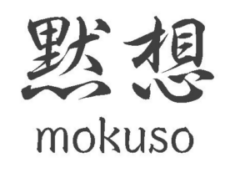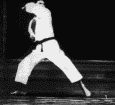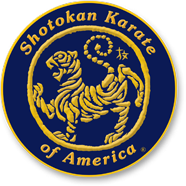
The Shotokan Karate club at the University of Pittsburgh class format allows all members to practice together whatever their level of skill and length of time training. Beginners are always welcome. Practice begins and ends with mokuso. Commonly translated as “meditation”, mokuso literally means “silent/still” (moku) + “thoughts/thinking” (so). At the begining of practice during this short seated meditation, we direct our breathing to our lower abdomen to deepen the connection between mind and body, emptying our minds of thoughts and everyday concerns to prepare ourselves for practice. When practice has ended, we do it again to prepare our minds to reenter everyday life.
Warm up and stretching exercises
Junbi Undo (準備運動) means “warm-up exercise.” These are preliminary exercises to awaken the mind and body in preparation for practice. Warming up increases respiration, heart rate, circulation, warms the musculature, tendons, ligaments and stimulates production of synovial fluid to lubricate the joints. Breathing is the main tool to release tension from the body. Releasing tension allows us to safely begin stretching the musculature, and opening up the ligaments, tendons, and joints.
Junbi Undo is not just something we do before practice; it is an important part of our practice. It allows us to move freely, and to connect our breathing, mind, and body as one. We must study and understand how and why to perform the movements of warming up, stretching, and cooling down, and how they relate to martial arts. This can help us gain additional insight into our practice of budo.
One of the main points of warming up, stretching, and cooling down is kokyū (呼吸), breathing. In our practice, the word “breathing” doesn’t refer only to respiration; it means more than that. We try to create some heat in our bodies, and intention through breathing. When we stretch and breathe in (inhale) we are trying to find more space, when we breathe out (exhale), we relax, yield to the earth and let go. Breathing is the main tool to release the tension in our bodies. In order for our muscles to relax, we hold a stretch while reaching into and directing our breathing through that area. It is important not to go too fast or to move robotically from one exercise to the next. Stretching tends to follow a similar pattern each practice, but may very depending on the goals of a particular practice or the needs of individuals participating. Consistent stretching is key to increasing flexibility, range of motion, and reducing the risk of muscle strain.
Some people won’t be able to perform all of these movements because of limitations due to injuries or physical problems. Any of these exercises can and should be modified as needed by each person. For instance, if someone has really bad knees, hips, ankles or back problems, they shouldn’t jump up and down. For those who can jump, jumping should be done lightly in order to reduce the shock of landing and avoid reverberating that shock into the joints.
Instruction will then begin involving a variety of techniques, including blocks, strikes, evasions, throws, and joint manipulations. Curriculum is divided into three areas: kihon (basics), kata (forms), and kumite (sparring). The practice concludes with another short sitting meditation.
Kihon – Basic Training
Kihon or (basic training) consists of the techniques and stances that occur most frequently in the kata. The kihon we usually practice are listed below. They may be performed individually or as combinations of techniques and may be done in the air or against a heavy bag, striking shield or focus mitts to provide resistance.
| Kihon | English | Stance |
| BLOCKING | ||
| Gedan Barai | down block | Zenkutsu-dachi (front stance) |
| Age-uke | rising head block | Zenkutsu-dachi (front stance) |
| Ude-uke | middle inside block | Zenkutsu-dachi (front stance) |
| Tettsui-uke | hammer fist block | Zenkutsu-dachi (front stance) |
| Shuto-uke | knife hand block | Kokusu-dachi (back stance) |
| STRIKING | ||
| Oi-zuki | lunge punch | Zenkutsu-dachi (front stance) |
| Gyaku-zuki | reverse punch | Zenkutsu-dachi (front stance) |
| Mae-te | jab | Zenkutsu-dachi (front stance) |
| Uraken | back fist strike | Kiba-dachi (horse riding stance) |
| KICKING | ||
| Mae-geri | front kick | Zenkutsu-dachi (front stance) |
| Mawashi-geri | roundhouse kick | Zenkutsu-dachi (front stance) |
| Yoko-geri Kekomi | side thrust kick | Kiba-dachi (horse riding stance) |
| Yoko-geri Keage | side up kick | Kiba-dachi (horse riding stance) |
| Mikazuki-geri | crescent kick | Kiba-dachi (horse riding stance) |
| Fumikomi | Stamping kick | Zenkutsu-dachi (front stance) |
| Ushiro-geri | back kick | Hachiji-dachi (natural stance) |

Kata – 形 or 型
There are two kanji characters that are used for the word kata. The first is the most recent and common usage. The left half of the character means shape and the right half means water. In other words, a container which holds the essence, water. The second character was used by some masters in earlier times. It translates to punishment above ground or to mold, maybe as in hammering on an anvil.
In SKA, we practice nineteen kata: Taikyoku Shodan, Nidan, and Sandan as forms for beginners; Heian Shodan, Nidan, Sandan, Yodan, and Godan, Bassai, Kwanku, Empi, Gankaku, all of the Shorin school (Northern Chinese ‘soft’ school); Tekki Shodan, Nidan, and Sandan, Jutte, Hangetsu, and Jion all of the Shorei school (Southern Chinese ‘hard’ school); and Ten no Kata as a kumite form. Master Funakoshi changed the names of some of these kata when he taught karate in Japan to make them more meaningful to the Japanese. In the past, the Heian kata were called ‘Pinan’ kata, the Tekki kata were called ‘Naifanchi, etc. Some of these forms have been practiced for 500 years or longer. Ten no Kata was developed during the last century.
Kata consist of a series of combinations of moving blocks, punches, kicks, joint techniques, and throwing which have been passed down from senior to junior for generations. Generally they have between 20 and 70 movements,
As we learn the order and rhythm of the kata, our understanding of the basic structure of the kata grows and we can gradually apply more strength. Once we have learned the order and acquired a feeling for the kata, we can then begin study of the next kata. Do not expect good results in a short time. Karate training may extend over one’s entire life, beginning ideally in junior high school years. Heavy training before the body is properly conditioned can result in injury to the body, so it is important to train consistently, without becoming impatient or overexerting yourself, gradually increasing application of force and numbers of exercises practiced.
Three important dynamics should be kept in mind during karate practice:
- light and heavy application of strength
- expansion and contraction of the body
- fast and slow movements in techniques
Practice each kata many times. 500 repetitions of a kata is a start. 5,000 repetitions is usually sufficient to begin to understand a kata. Many more repetitions and working with partners is required to deeply understand a kata. Try to perform kata smoothly and precisely, without unnecessary tension in the body, in a very alert and focused frame of mind, in exact stance and posture, with attention to dynamics of speed, application of power, expansion and contraction, mindful of the meaning or practical application of the kata.
Kumite – 組手
Kumi means to unite, cooperate or grapple and te means hand, way, trick, move or technique. So, in kumite you are working with your partner to improve each others fighting abilities by exploring various aspects such as timing and distance, footwork, fluidity, mental focus, ability to feel your opponents intention, how you connect to the ground, pulling hand, applications of movements found in kata, grappling, escaping from or throwing your partner. This is only a partial list. There are many ways to practice kumite.
Sparring is a form of kumite now popular as a competitive sport which limits the techniques used and targets allowed to protect participants from injury. It has value in helping to utilize many of the aspects mentioned above in a stressful situation, but should not be the end goal of your karate practice. Engagements may be prearranged between participants where one applies offensive and the other utilizes defensive techniques, or it may be free form. Karate, to the very end, should be practiced with kata as the principal method and sparring as a supporting method.
Karate-ni sente nashi 空手に先手 無し [ からてに せんて なし ]
- Karate 空手 [ からて ] (literally ‘empty handed’)
- ni [ に ] means ‘toward’ ‘karate-ni’ could be read ‘in karate’ or ‘toward karate’.
- Sente 先手 [ せんて ] (literally ‘first hand’) means ‘the first move’
- Nashi 無し [ なし ] literally ‘without’) means ‘does not exist’
So ‘karate-ni sente nashi’ means ‘the first attack does not exist in karate’ – a fundamental strategy in karate-do is to draw the opponent in to commit to a first attack – at the moment he does, you destroy him. (this phrase can also be translated, ‘there is no first attack in karate’). It has long been said that there is no advantage to the one who makes the first attack in karate.
The front arm may be used for defense with the other positioned ready for offense, but this may change in an instant. Blocks may be used to strike an opponents limb, disrupt their advance or uproot and destroy their balance.
Below are some basic forms of kumite:
| Ten no Kata Ura | prearranged single engagement matches |
| continuous attacks | |
| Sanbon gumite | triple engagement match |
| Ippon gumite | single engagement match |
| Jiyu-ippon gumite | free single engagement match |
| Jiyu kumite | free sparring |
| Torite | escaping |
| Suwari-waza | seated techniques |
| Nage jiyu kumite | long distance free sparring |
| Nage-no-waza | throwing techniques |
| Iai | closest distance single engagement match |
Courtesy of Simone Degan – simonedegan.com
